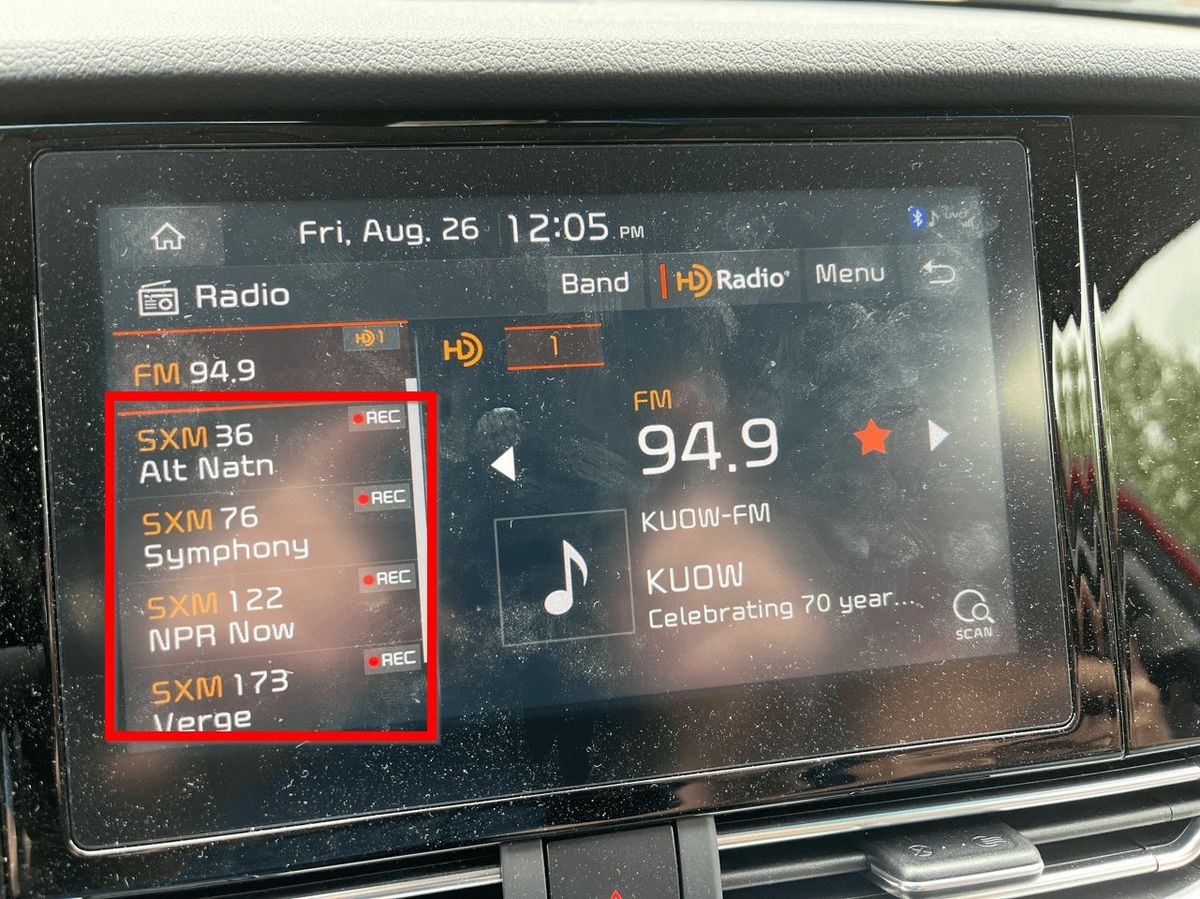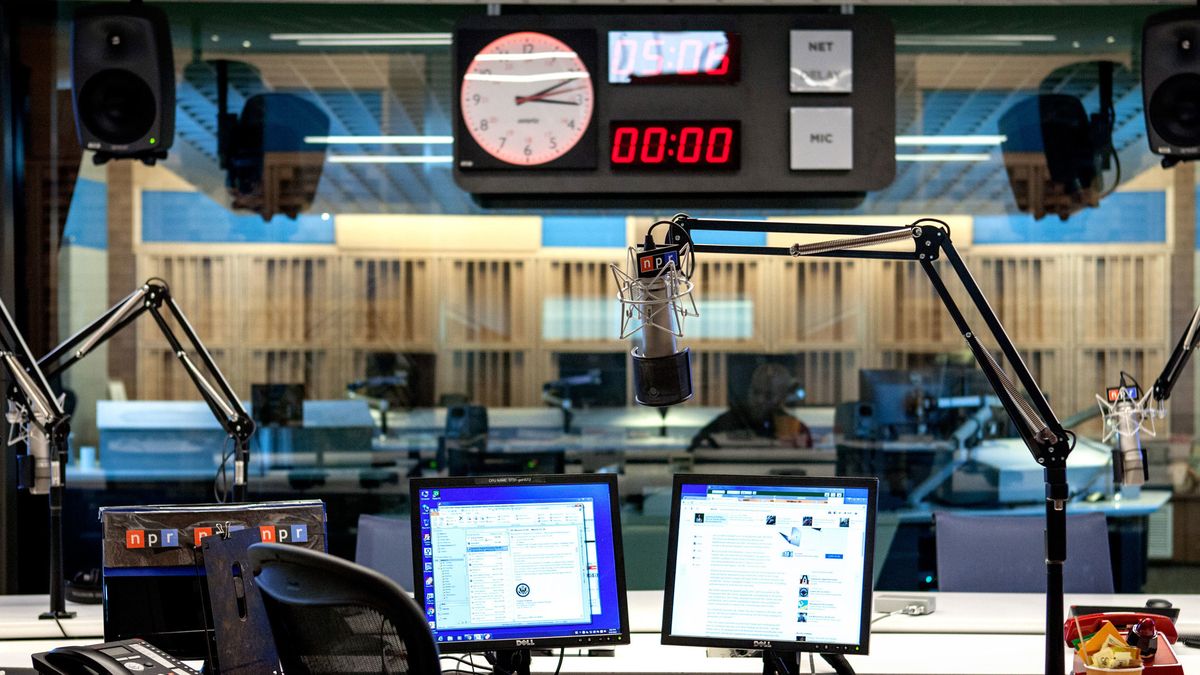Home>Devices & Equipment>Radio>How Do You Start A Radio Station


Radio
How Do You Start A Radio Station
Modified: January 22, 2024
Learn how to start a radio station and share your love for radio with the world. Discover the essential steps and tips to create your own successful radio venture.
(Many of the links in this article redirect to a specific reviewed product. Your purchase of these products through affiliate links helps to generate commission for AudioLover.com, at no extra cost. Learn more)
Table of Contents
- Introduction
- Step 1: Planning for your radio station
- Step 2: Securing the necessary licenses and permits
- Step 3: Choosing the right equipment
- Step 4: Setting up your broadcasting studio
- Step 5: Building your music library
- Step 6: Hiring and training staff
- Step 7: Creating engaging content for your radio station
- Step 8: Promoting and marketing your radio station
- Step 9: Launching your radio station
- Step 10: Maintaining and growing your radio station
- Conclusion
Introduction
Welcome to the fascinating world of radio! Starting your own radio station can be a thrilling journey filled with creativity, entertainment, and community engagement. From delivering captivating music and news to providing a platform for local artists and voices, radio stations have the power to connect and resonate with audiences on a personal level.
However, launching a radio station requires careful planning, technical knowledge, and a deep understanding of the industry. This article will guide you through the essential steps to start your own radio station, ensuring that you have a solid foundation for success.
Before diving into the practical aspects of setting up a radio station, it’s important to define your goals and vision. What type of radio station do you want to create? Will it focus on a particular genre of music, offer local news and community updates, or provide a platform for niche interests? Understanding your target audience and the unique value you want to bring to the airwaves will shape your decisions throughout the process.
Additionally, it’s crucial to familiarize yourself with the legal and regulatory requirements of operating a radio station. Each country has its own licensing and permit procedures that must be followed. These can include obtaining broadcast licenses, music licensing agreements, and adhering to specific broadcasting standards. Compliance with these regulations is essential to avoid legal issues down the road.
Once you have a clear idea of your station’s vision and have familiarized yourself with the necessary legal procedures, it’s time to embark on the exciting journey of setting up your own radio station. From choosing the right equipment to creating engaging content, we will guide you through every step of the process to ensure your radio station thrives and becomes a beloved part of your community.
Step 1: Planning for your radio station
Planning is the foundation of any successful endeavor, and starting a radio station is no different. Taking the time to thoroughly plan your radio station will help you to define your goals, target audience, and overall strategy. Here are some key considerations to keep in mind during the planning phase:
- Define your station’s identity: Before you can start broadcasting, you must have a clear understanding of what your station will be all about. Will it cater to a specific music genre, offer talk shows, cover news and current affairs, or focus on a specific community or demographic? Defining your station’s identity will help you immensely when it comes to selecting content, attracting advertisers, and building an audience.
- Research your target audience: Understanding your target audience is crucial for creating content that resonates with them. Conduct market research to determine their preferences, interests, and listening habits. This will help you tailor your programming to their tastes and ensure that you’re delivering content that they will enjoy.
- Create a programming schedule: Developing a programming schedule is one of the most important aspects of planning your radio station. Determine the types of shows and content you want to include and create a balanced schedule that caters to a variety of interests. Consider the optimal times for different types of shows and how they will flow together throughout the day.
- Identify potential revenue streams: While passion for radio is essential, it’s also important to consider the financial side of things. Explore different revenue streams such as advertising, sponsorships, events, and partnerships. Having a clear plan for monetization will help sustain your station in the long run.
- Set realistic goals: It’s important to set achievable goals for your radio station. Whether it’s reaching a certain number of listeners, securing a specific number of advertisers, or gaining recognition in your community, setting measurable goals will help you stay focused and motivated.
By completing thorough planning, you will have a strong foundation for your radio station and a clear road map to guide you through the next steps. Remember to stay true to your station’s identity and target audience as you move forward in the exciting journey of starting your own radio station.
Step 2: Securing the necessary licenses and permits
Operating a radio station requires obtaining the necessary licenses and permits to ensure compliance with legal and regulatory requirements. Each country has its own specific rules and procedures, so it’s important to familiarize yourself with the requirements in your jurisdiction. Here are the key steps to secure the necessary licenses and permits for your radio station:
- Research the regulatory authority: Start by identifying the regulatory authority responsible for overseeing broadcasting in your country. This could be a government body or an independent organization. Visit their website or contact them directly to understand the process and requirements for obtaining a broadcast license.
- Understand the licensing process: Familiarize yourself with the specific steps involved in the licensing process. This may include submitting an application, providing supporting documents, paying fees, and undergoing background checks. Make sure you have a clear understanding of the timeline and any restrictions or conditions associated with the license.
- Prepare the required documents: Gather all the necessary documentation as per the regulatory authority’s requirements. This may include your station’s business plan, financial statements, proof of ownership or lease agreement for your facilities, and any other supporting documents they may request.
- Submit your application: Complete the application process by submitting all the required documents and paying the necessary fees. Make sure to double-check your application for completeness and accuracy to avoid any delays or rejections.
- Comply with music licensing: Alongside the broadcast license, you will also need to ensure compliance with music licensing. This allows you to play copyrighted music on your station. Research the appropriate music licensing organizations in your country and obtain the necessary licenses or agreements to legally include music in your programming.
- Stay up to date with regulations: Once you have obtained the necessary licenses and permits, it’s important to stay informed about any changes or updates in the regulatory landscape. Regularly check for updates from the regulatory authority and ensure you are continuing to meet all the requirements and obligations of your license.
Securing the necessary licenses and permits is a crucial step in establishing your radio station as a legitimate and compliant broadcaster. It may require time and effort, but it is essential to ensure that you are operating within the legal framework and safeguarding the rights of all stakeholders involved.
Step 3: Choosing the right equipment
Selecting the right equipment for your radio station is vital to ensure smooth operations and high-quality broadcasts. From microphones and mixers to transmitters and broadcasting software, each piece of equipment plays a crucial role in delivering a professional sound and maintaining a seamless broadcasting experience. Here are some key factors to consider when choosing the right equipment:
- Determine your budget: It’s important to establish a budget for your equipment upfront. Consider both the initial costs of purchasing the equipment and any ongoing maintenance and upgrade expenses. Allocate your budget to prioritize essential items without compromising on quality.
- Assess your technical needs: Evaluate the specific technical requirements of your radio station. Consider factors such as the number of studios, the size of your broadcasting area, and the number of simultaneous broadcasts you expect to handle. This will help you determine the appropriate scale and capabilities of the equipment you need.
- Research reputable brands: Look for trusted and reputable brands in the industry. Research equipment reviews, seek recommendations from industry professionals, and compare specifications and features to ensure you choose reliable and high-performing equipment that will meet your needs.
- Consider compatibility: Ensure that the equipment you select is compatible with each other and any existing systems you may have. Check compatibility with your broadcasting software, audio interfaces, and other devices to avoid any technical issues or limitations.
- Test equipment before purchasing: Whenever possible, test equipment before making a final purchase. Visit audio equipment stores or attend industry trade shows to have a hands-on experience with different products. This will help you assess the build quality, user-friendliness, and sound quality of the equipment.
- Seek professional advice: If you are uncertain about the technical aspects of choosing equipment, consider consulting with expert professionals such as broadcast engineers or audio consultants. They can provide guidance and help you make informed decisions that align with your specific needs and budget.
Remember, the right equipment can significantly impact the overall quality of your broadcasts. Investing in reliable and suitable equipment from the beginning will ensure that your radio station operates smoothly and delivers a professional sound that engages your listeners.
Step 4: Setting up your broadcasting studio
Your broadcasting studio is the heart of your radio station, where all the magic happens. Creating a functional and well-equipped studio is essential to ensure smooth operations and produce high-quality broadcasts. Here are some key steps to consider when setting up your broadcasting studio:
- Design the layout: Plan the layout of your studio to optimize workflow and ensure easy accessibility to equipment. Consider the placement of broadcasting desks, chairs, equipment racks, and other essential elements. Ensure that the layout allows for adequate space and comfort for hosts, guests, and technical staff.
- Choose the right furniture and acoustic treatment: Select ergonomic furniture that provides comfort and functionality for hosts and operators. Invest in acoustic treatment materials such as soundproofing insulation, diffusors, and bass traps to minimize external noise and improve sound quality in the studio.
- Install broadcasting equipment: Set up your broadcasting equipment in the studio, including microphones, headphones, audio interfaces, mixers, and recorders. Ensure that all equipment is connected properly and functioning correctly. It’s also crucial to organize cables and manage cable clutter to maintain a tidy and efficient workspace.
- Configure your broadcasting software: Install and configure broadcasting software on your broadcasting computer or dedicated broadcast server. This software allows you to manage playlists, schedule advertisements, and control audio levels during live broadcasts. Familiarize yourself with the software’s features and settings to optimize your broadcasting workflow.
- Test and calibrate audio equipment: Perform thorough testing and calibration of your audio equipment to ensure proper sound quality. Use audio measurement tools and software to adjust audio levels, equalization, and other settings. Regularly monitor and maintain your audio equipment to ensure consistent performance.
- Set up backup systems: To mitigate the risk of technical failures during live broadcasts, set up backup systems for critical equipment such as transmitters, audio sources, and broadcasting software. Implement redundant power supplies, backup audio sources, and failover systems to quickly switch to backup solutions when necessary.
- Create a comfortable environment: Make the studio environment comfortable for hosts and operators. Consider factors such as lighting, temperature control, and adequate ventilation to ensure a pleasant and conducive space for recording and broadcasting. A comfortable environment can positively impact the performance and creativity of your team.
Setting up your broadcasting studio requires careful planning and attention to detail. By creating a well-designed and functional space, you can provide a seamless and enjoyable experience for your hosts, guests, and listeners, resulting in professional broadcasts that captivate your audience.
Step 5: Building your music library
A well-curated music library is a fundamental component of any radio station. It sets the tone, captures the interest of listeners, and keeps them coming back for more. Building a diverse and extensive music library ensures that you have an ample selection of songs to meet the tastes and preferences of your target audience. Here are some key steps to consider when building your music library:
- Identify your target audience: Understand the demographics and musical preferences of your target audience. Whether your radio station focuses on a specific genre, era, or niche, tailoring your music library to their tastes is paramount. Consider conducting surveys or market research to gain insights into their favorite genres, artists, and songs.
- Research music industry resources: Utilize music industry resources to discover new and popular songs. Subscribe to music charts, follow music blogs, and stay active on music streaming platforms to keep up with the latest releases and trends. Networking with music industry professionals and attending industry events can also provide valuable insights and opportunities for acquiring new music for your library.
- Acquire legal music rights: It’s essential to acquire legal rights to the music in your library. This can be done through purchasing individual tracks or obtaining licenses from music licensing organizations, such as ASCAP, BMI, or SESAC. These licenses allow you to legally broadcast copyrighted music and ensure that artists receive proper compensation.
- Diversify your music selection: A diverse music library will help cater to a broader range of tastes and keep your programming fresh and engaging. Include a mix of popular hits, emerging artists, local talent, and deep cuts. Consider including different sub-genres, styles, and eras to create variety in your programming.
- Organize and catalog your music: Implement an efficient system for organizing and cataloging your music library. Use appropriate software to manage metadata, create playlists, and easily search for songs based on genre, artist, or other criteria. Proper organization will help facilitate smooth workflow during live broadcasts and allow for quick access to the right songs.
- Regularly update and refresh your library: Continuously update your music library to stay current and cater to evolving musical trends. Regularly remove outdated or unpopular tracks and add new releases or emerging artists. Engage with your listeners to gather feedback on their favorite songs and incorporate their suggestions into your library.
- Promote local and independent artists: Showcase and promote local talent and independent artists in your music library. This not only supports emerging artists but also helps create a unique identity for your radio station. Consider featuring special programs or dedicated slots to highlight their work and engage with the local community.
Building a well-rounded music library takes time and effort, but it’s an essential investment for the success of your radio station. By curating a diverse collection of music that resonates with your target audience, you can create a captivating listening experience that keeps listeners tuned in and eager for more.
Step 6: Hiring and training staff
Building a strong and competent team is crucial for the success of your radio station. Hiring and training staff who are passionate, skilled, and aligned with your station’s vision will help create engaging and compelling content that resonates with your target audience. Here are some key steps to consider when hiring and training staff for your radio station:
- Define job roles and responsibilities: Clearly outline the job roles and responsibilities for the various positions in your radio station. Determine the number of hosts, DJs, producers, engineers, and administrative staff you need to effectively run your station. This will help you identify the specific skill sets and qualifications required for each role.
- Advertise job openings: Advertise job openings through multiple channels to attract a diverse pool of candidates. Utilize online job boards, industry-specific websites, social media platforms, and local community networks. Clearly communicate the required qualifications, experience, and any specific skills or knowledge relevant to the position.
- Conduct interviews: Thoroughly screen candidates and conduct interviews to assess their suitability for the role. Look for individuals who demonstrate a genuine passion for radio, excellent communication skills, creativity, and an ability to work well within a team dynamic. Pay attention to their previous experience in radio, knowledge of music genres, and familiarity with broadcasting software and equipment.
- Provide comprehensive training: Once you have hired your staff, provide comprehensive training to ensure they are equipped with the skills and knowledge needed to excel in their roles. Train them on the technical aspects such as operating broadcasting equipment, using software, and understanding broadcasting regulations. Additionally, provide training on content creation, show hosting, interview techniques, and engaging with listeners.
- Cultivate a positive work culture: Foster a positive work culture that encourages creativity, collaboration, and continuous learning. Create an environment where staff members feel valued, supported, and motivated to contribute their best work. Encourage open communication, provide constructive feedback, and recognize achievements to boost morale and team cohesion.
- Promote ongoing professional development: Encourage your staff to engage in ongoing professional development to enhance their skills and stay updated with industry trends. Provide opportunities for attending workshops, conferences, and industry events. Support them in pursuing certifications or additional training that can benefit their roles and contribute to the growth of the radio station.
- Empower creativity and innovation: Encourage your staff to bring their creative ideas and innovative concepts to the table. Foster an environment where new content ideas, formats, and programming initiatives are welcomed. Allow room for experimentation and continuous improvement, as this will help your station stand out and attract a loyal audience.
Hiring and training the right staff is crucial for the success of your radio station. By assembling a talented and passionate team, you can produce captivating content, establish a strong brand identity, and cultivate a loyal listener base. Remember to invest in their development, foster a positive work environment, and empower them to bring their best to the airwaves.
Step 7: Creating engaging content for your radio station
Creating engaging and compelling content is the lifeblood of any successful radio station. It is what keeps listeners tuned in, attracts new audiences, and sets your station apart from the competition. Developing a content strategy that resonates with your target audience and aligns with your station’s brand is crucial. Here are some key steps to consider when creating engaging content for your radio station:
- Understand your target audience: Gain a deep understanding of your target audience’s preferences, interests, and behaviors. Conduct regular audience research, analyze listener feedback, and monitor trends to create content that appeals to their tastes and appeals to their interests.
- Offer a variety of content: Provide a diverse range of content to cater to different listener interests. Mix music with talk shows, interviews, news updates, and special segments to keep your programming fresh and varied. Incorporate both familiar favorites and new discoveries to maintain listener engagement.
- Create compelling playlists: Curate playlists that are well-structured and diverse, with a mix of popular hits and lesser-known tracks. Consider the energy levels, transitions between songs, and the overall flow of the playlist to provide an enjoyable listening experience. Tailor playlists to specific times of the day or theme-based shows to keep things interesting.
- Develop captivating talk shows and segments: Engage listeners with interesting and meaningful talk shows and segments. Cover topics that are relevant to your audience, include guest interviews, and encourage listener interaction through phone-ins, social media, or live chat. Keep the conversation lively, informative, and entertaining.
- Feature local talent and community voices: Showcase local musicians, artists, and community figures to foster a sense of local connection and support. Feature their work, conduct interviews, and promote local events to strengthen your station’s ties with the community and generate interest among local audiences.
- Stay informed and relevant: Keep up with the latest news and current affairs to provide timely and relevant updates to your listeners. Stay informed about cultural events, community happenings, and trending topics that are of interest to your audience. This will demonstrate your station’s relevance and keep your content fresh and engaging.
- Embrace interactivity: Encourage listener interaction through contests, polls, requests, and shout-outs. Implement interactive elements such as live call-ins, social media integration, and listener dedications. Including your audience in the content creation process will foster a sense of community and increase listener loyalty.
- Experiment and adapt: Don’t be afraid to try new ideas and formats. Experiment with different content styles, segments, and show formats to discover what resonates best with your audience. Monitor listener feedback, ratings, and engagement metrics to constantly assess and adapt your content strategy.
Remember, creating engaging content is an ongoing process that requires continuous effort and adaptation. By understanding your audience, diversifying your content, and staying relevant, you can deliver compelling programming that keeps listeners engaged, entertained, and coming back for more.
Step 8: Promoting and marketing your radio station
Promoting and marketing your radio station is vital to increase its visibility, attract new listeners, and build a loyal audience. Effective promotion and marketing strategies can help you create awareness about your station, differentiate yourself from competitors, and position your brand in the minds of your target audience. Here are some key steps to consider when promoting and marketing your radio station:
- Develop a strong brand identity: Create a distinct and recognizable brand identity for your radio station. Develop a memorable logo, design appealing visuals, and establish a consistent tone and voice across all communication channels. Your brand should reflect the essence of your station and resonate with your target audience.
- Utilize social media: Leverage the power of social media to connect with your audience and promote your station. Create engaging content, post regular updates, and interact with your followers. Encourage listeners to share their experiences, organize contests, and utilize social media advertising to reach a wider audience.
- Partner with local businesses and organizations: Forge partnerships with local businesses, organizations, and events to increase your station’s visibility. Sponsor community events, collaborate with local musicians or artists, and establish cross-promotional partnerships. This not only raises brand awareness but also strengthens your ties to the local community.
- Collaborate with influencers and bloggers: Collaborate with influential individuals in your niche, such as popular bloggers, vloggers, or social media influencers. Invite them for interviews or guest appearances, ask for reviews or shout-outs, and leverage their reach to expand your listener base.
- Implement SEO strategies: Optimize your radio station’s website for search engines to increase organic traffic. Conduct keyword research to identify relevant keywords and integrate them into your website content, meta tags, and URLs. Leverage backlinks, local directories, and online reviews to improve your website’s search engine ranking.
- Advertise through various channels: Explore advertising opportunities through various channels, such as traditional radio ads, print media, online banner ads, and mobile advertising. Consider the demographics and listening habits of your target audience to choose the most effective advertising channels.
- Engage with your audience: Interact with your listeners through various channels, including social media, live events, and feedback platforms. Respond to their comments, messages, and feedback in a timely and personalized manner. Make your audience feel valued and appreciated, as this fosters loyalty and develops a strong listener community.
- Monitor and analyze performance: Regularly monitor and analyze key performance metrics to assess the effectiveness of your promotional efforts. Track audience growth, engagement levels, website traffic, and social media metrics. Use this data to refine your marketing strategies and optimize your promotional campaigns.
Promoting and marketing your radio station requires a multi-faceted approach that leverages various channels and strategies. By creating a strong brand, utilizing social media, collaborating with influencers, and analyzing performance, you can effectively promote your radio station and attract a dedicated and enthusiastic audience.
Step 9: Launching your radio station
After all the planning and preparation, it’s time to launch your radio station and bring your vision to life. This is an exciting and pivotal moment that requires careful execution and attention to detail. Here are some key steps to consider when launching your radio station:
- Finalize your programming schedule: Refine and finalize your programming schedule, ensuring a balanced mix of content and music that aligns with your target audience’s preferences and interests. Make sure you have sufficient content to cover the initial days or weeks of broadcasting.
- Test your broadcast equipment: Perform thorough testing of all your broadcast equipment and software to ensure they are functioning properly. Conduct test broadcasts to monitor sound quality, check for any technical issues, and adjust levels as needed. Ensure that all backup systems are in place and functioning as intended.
- Prepare promotional materials: Create promotional materials such as station jingles, sweepers, and commercials to establish your brand identity. Develop eye-catching graphics, logos, and taglines that will be used in various marketing materials. Ensure a consistent visual and audio identity across all platforms.
- Launch a marketing campaign: Develop and execute a comprehensive marketing campaign to create excitement and generate buzz around your radio station launch. Utilize all available channels such as social media, local newspapers, online advertising, and community events to spread the word about your station and encourage listeners to tune in.
- Engage with your audience: Actively engage with your audience during the launch phase. Respond to messages, comments, and feedback in a timely and personalized manner. Create interactive promotions, contests, or giveaways to encourage listener participation and build a loyal listener base right from the start.
- Monitor and evaluate: Continuously monitor and evaluate the performance of your radio station during the initial launch phase. Track key metrics such as listener numbers, feedback, social media engagement, and advertising effectiveness. Use this data to gauge the success of your launch campaign and make any necessary adjustments to improve your station’s performance.
- Adjust and optimize: Based on the feedback and data gathered during the launch phase, make necessary adjustments and refinements to your programming, marketing strategy, and overall operations. Listen to your audience’s preferences and adapt your content to better cater to their interests. Continuously strive to improve and optimize your radio station based on audience feedback and industry trends.
Launching your radio station is an exciting milestone that marks the beginning of your broadcasting journey. By carefully planning the launch, executing a well-rounded marketing campaign, and listening to your audience’s feedback, you can make a strong and memorable entrance into the airwaves and establish a solid foundation for your radio station’s future success.
Step 10: Maintaining and growing your radio station
Maintaining and growing your radio station is an ongoing process that requires dedication, adaptability, and commitment to providing quality content. It’s important to continuously evaluate and improve your operations, engage with your audience, and seek opportunities for growth. Here are some key steps to consider when maintaining and growing your radio station:
- Regularly assess your programming: Continuously evaluate your programming to ensure that it remains relevant and engaging for your audience. Stay up-to-date with music trends, listener preferences, and industry developments. Regularly seek feedback from your audience through surveys, focus groups, and social media interactions to make informed decisions about content adjustments.
- Engage with listeners: Foster a strong connection with your listeners by actively engaging with them. Encourage feedback, questions, and suggestions through social media, email, and phone-ins. Incorporate listener requests and interactions into your programming to create a sense of community and develop loyal listeners.
- Explore new content ideas: Continuously explore and experiment with new content ideas to keep your programming fresh and engaging. Introduce new shows, segments, or features that align with audience interests. Collaborate with guests, experts, or community figures to bring diverse perspectives and fresh voices to your station.
- Stay current with technology: Keep up with advancements in broadcasting technology to ensure your station remains competitive and relevant. Explore new tools, software, and equipment that can enhance your operations and improve the quality of your broadcasts. Embrace streaming platforms and other digital channels to reach a wider audience.
- Collaborate with partners: Forge partnerships with like-minded businesses, organizations, or influencers to expand your reach and tap into new audience segments. Collaborate on content, events, or cross-promotions to mutually benefit from each other’s networks and increase your station’s visibility.
- Monitor and analyze performance: Regularly monitor audience metrics, listener feedback, and advertising effectiveness to gauge the performance of your radio station. Use this data to identify areas for improvement, make informed decisions, and optimize your programming and promotional strategies.
- Invest in marketing and promotion: Continue to invest in marketing and promotion to expand your listener base and increase brand awareness. Utilize various channels such as social media, online advertising, and local events to reach new audiences. Leverage your existing listeners to spread the word about your station through word-of-mouth referrals.
- Pursue community involvement: Get involved in the local community by sponsoring events, supporting charitable causes, and partnering with local organizations. Engaging with the community not only strengthens your brand presence but also fosters loyalty among local listeners and businesses.
- Seek feedback and adapt: Regularly seek feedback from your audience, advertisers, and staff to continuously improve your station. Embrace constructive criticism, learn from mistakes, and adapt your strategies. Stay agile to meet the evolving needs and preferences of your audience and industry.
- Stay passionate and committed: Maintain your passion and commitment to delivering quality content and serving your audience. Keep your team motivated, foster a positive work environment, and continuously seek ways to innovate and exceed expectations.
Maintaining and growing your radio station requires ongoing effort and dedication. By staying responsive to listener feedback, embracing new technologies, and nurturing your community, you can create a thriving radio station that continues to engage and captivate audiences for years to come.
Conclusion
Starting and running a radio station is an exhilarating endeavor that combines creativity, technical expertise, and a deep understanding of your audience. By following the essential steps outlined in this guide, you can lay a solid foundation for success and create a radio station that captivates and resonates with your listeners.
From the initial planning stages to the launch and ongoing maintenance, each step is crucial to ensure a smooth and engaging broadcasting experience. Planning allows you to define your station’s identity and understand the legal requirements. Securing the necessary licenses and permits ensures compliance and legitimacy.
Choosing the right equipment and setting up a well-designed broadcasting studio enables you to deliver professional sound quality. Building a diverse music library and creating engaging content cater to your audience’s tastes and keep them hooked. Hiring and training a dedicated team who share your passion for radio elevates your programming and operations.
Promoting and marketing your radio station helps you expand your reach and attract new listeners. Launching your station is an exciting milestone, and maintaining and growing it requires continuous evaluation, engagement, and adaptation to changing industry trends.
Ultimately, the success of your radio station lies in your ability to connect with your audience, deliver captivating content, and create a sense of community. By staying committed, innovative, and customer-focused, you can build a loyal listener base, establish your station as a trusted source of entertainment and information, and make a lasting impact in the world of radio.











